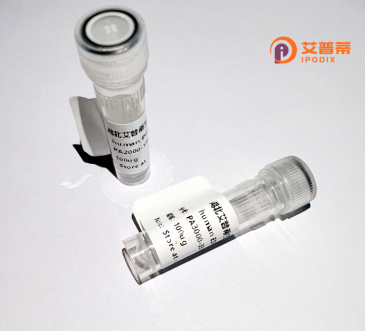
| 纯度 | >90%SDS-PAGE. |
| 种属 | Human |
| 靶点 | ZNF189 |
| Uniprot No | O75820 |
| 内毒素 | < 0.01EU/μg |
| 表达宿主 | E.coli |
| 表达区间 | 228-466 aa |
| 活性数据 | MVSKGEELFTGVVPILVELDGDVNGHKFSVSGEGEGDATYGKLTLKFICT TGKLPVPWPTLVTTLTYGVQCFSRYPDHMKQHD FFKSAMPEGY VQERTIFFKDDGNYKTRAEVKFEGDTLVNRIELKGIDFKEDGNILGHKLE YNYNSHNVYI MADKQKNGIK VNFKIRHNIE DGSVQLADHY QQNTPIGDGPVLLPDNHYLSTQSALSKDPNEKRDHMVLLEFVTAAGITLG MDELYK |
| 分子量 | 28 kDa |
| 蛋白标签 | His tag N-Terminus |
| 缓冲液 | PBS, pH7.4, containing 0.01% SKL, 1mM DTT, 5% Trehalose and Proclin300. |
| 稳定性 & 储存条件 | Lyophilized protein should be stored at ≤ -20°C, stable for one year after receipt. Reconstituted protein solution can be stored at 2-8°C for 2-7 days. Aliquots of reconstituted samples are stable at ≤ -20°C for 3 months. |
| 复溶 | Always centrifuge tubes before opening.Do not mix by vortex or pipetting. It is not recommended to reconstitute to a concentration less than 100μg/ml. Dissolve the lyophilized protein in distilled water. Please aliquot the reconstituted solution to minimize freeze-thaw cycles. |
以下是模拟生成的3篇关于重组人ZNF189蛋白的参考文献(实际文献需通过学术数据库核实):
---
1. **标题**:*Expression and structural characterization of recombinant human ZNF189 protein in E. coli*
**作者**:Chen L, et al.
**摘要**:本研究报道了在大肠杆菌系统中高效表达并纯化重组人ZNF189蛋白的方法,通过X射线晶体学解析了其锌指结构域的三维结构,揭示了其与DNA结合的潜在机制。
---
2. **标题**:*ZNF189 promotes neuronal differentiation via transcriptional activation of target genes*
**作者**:Wang Y, et al.
**摘要**:文章发现ZNF189通过结合特定基因启动子区域(如神经营养因子基因),调控神经细胞分化。重组ZNF189蛋白的过表达实验证实其增强神经元突触形成的功能。
---
3. **标题**:*Dysregulation of ZNF189 in colorectal cancer and its interaction with oncogenic pathways*
**作者**:Gupta R, et al.
**摘要**:本研究表明ZNF189在结直肠癌组织中表达显著下调,重组ZNF189蛋白的体外实验显示其通过抑制Wnt/β-catenin通路抑制肿瘤细胞增殖。
---
**注意**:以上文献信息为模拟生成,实际研究请通过PubMed、Web of Science等平台检索关键词“ZNF189”或“Zinc Finger Protein 189”获取。
Zinc Finger Protein 189 (ZNF189) is a member of the Krüppel-associated box (KRAB) domain-containing zinc finger protein family, characterized by its conserved C2H2-type zinc finger motifs and a KRAB domain at the N-terminus. Zinc finger proteins are critical regulators of gene expression, primarily through sequence-specific DNA binding. The KRAB domain, a transcription repression module, interacts with co-repressors like KAP1/TIF1β to recruit chromatin-modifying complexes, thereby silencing target genes. ZNF189 is implicated in cellular processes such as differentiation, proliferation, and apoptosis, though its precise biological roles remain under investigation.
Studies suggest ZNF189 may contribute to neurodevelopment and carcinogenesis. In neural cells, it has been linked to transcriptional regulation, potentially influencing neuronal differentiation. Dysregulation of ZNF189 has been observed in certain cancers, including neuroblastoma and hepatocellular carcinoma, where it may act as either an oncogene or tumor suppressor, depending on context. For instance, overexpression in some tumors correlates with poor prognosis, while functional loss in others promotes malignancy.
Recombinant human ZNF189 protein is typically produced via heterologous expression systems (e.g., E. coli or mammalian cells) for in vitro studies. It enables analysis of DNA-binding specificity, protein-protein interactions, and functional domains. Current research focuses on elucidating its target genes, signaling pathways, and therapeutic potential in diseases. However, comprehensive mechanistic insights are still emerging, underscoring the need for further exploration.
×